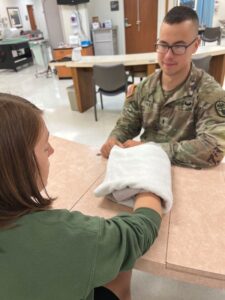
Snyder a local artist and military spouse stationed at the Joint Readiness Training Center and Fort Johnson, Louisiana was featured in a story titled, “BJACH hand rodeo: One patient’s journey,” published Aug. 24, 2023.
Story by Jean Graves
Bayne-Jones Army Community Hospital
FORT JOHNSON, La. — April is Occupational Therapy month and Bayne-Jones Army Community Hospital provides a robust OT program for Soldiers and retirees in the Fort Johnson community.
The BJACH public affairs officer sat down with 1st Lt. Jonathan Ekas, an occupational therapist, to learn more about the profession, his motivation for pursuing the vocation and what BJACH is doing to raise awareness of occupational therapy in April.
Question: What is occupational therapy?
Answer: To explain occupational therapy, we first need to provide context to the term “occupations.” Occupations are tasks that individuals do daily. Activities such as self-care; bathing, going to the bathroom, dressing, hygiene, or other activities like driving, cleaning the house, child-care, work, play, and social participation are all considered occupations.
As an OT, we evaluate dysfunction, whether it be physical ailments, emotional or psychological dysfunction. Then, we provide treatment to help patients adapt the task or provide remedial intervention for them to regain independence while performing these tasks.
Question: How does this apply to Soldiers at JRTC and Fort Johnson?
Answer: We treat soldiers with the goal of independence and returning them to duty without restrictions as quickly as possible. We want to treat their condition to improve their quality of life at work and home.
Question: What about our retiree population?
Answer: For older patients, the goal is to create a plan dependent on what the patient needs and wants to be able to do.
Question: What are common reasons beneficiaries are referred to occupational therapy?
Answer: Specifically, for our clinic at BJACH, we treat a lot of orthopedic conditions from the shoulder to fingertip, as well as concussion and post-concussion care.
Question: What is a “typical” treatment plan for these conditions?
Answer: For orthopedic conditions, our treatment plan primarily consists of splinting, range of motion and strengthening. Additionally, we work on gross motor and fine motor coordination exercises, simulating the skills necessary to engage in occupational tasks needed for daily life function. We also use a variety of modalities to control pain and prepare patients for treatment.
For patients with traumatic brain injuries, the treatment plan uses habituation exercises to normalize various vestibular sensations. We try to retrain the brain to take in the stimuli needed to engage in their daily lives without unwanted symptoms that can limit what they can or cannot do.
Question: How does occupational therapy change lives and improve quality of life?
Answer: Occupational therapy is a client-centered discipline focusing on restoring function and regaining independence in daily life. Practitioners focus beyond treating the ailments by including the “what’s next” part in the plan of care. We treat conditions like any other discipline, but we are geared towards teaching and training our patients the skills needed to perform their own self-care, home management tasks, hobbies, and the vocational duties needed to succeed in their personal and professional lives. Their quality of life is improved when we can help them regain their independence, so they advocate for themselves. This process helps them build the confidence necessary to return to doing the things they enjoy.
Question: Why did you become an occupational therapist?
Answer: I became interested in occupational therapy when I was an undergraduate studying health science. Internships with various providers including dietitians, physical therapists, physician assistants, and occupational therapy were a required part of my education.
When shadowing occupational therapy, I witnessed individuals go from bedridden to returning to the things they loved. Through their occupational treatment plans, they were able to start gardening, walking their dogs, knitting and being able to care for themselves at home independently again.
The foundational principle of occupational therapy is to empower a patient’s return to independence and the activities they value. The focus of care is to restore patient’s lives versus treating the condition and calling it a day. This type of care really attracted me. Giving patients’ their lives back motivates and gives me purpose daily.
Question: What does it take to become an occupational therapist?
Answer: To become an occupational therapist, you need to earn a four-year degree in an allied health concentration. Next, students need to apply for a suitable graduate program. I earned my master’s degree; however, in 2027, occupational therapy practitioners will require a doctorate degree. This means new therapists will need four to six years of additional education beyond the bachelor’s level, depending on the university they attend. After completing the doctorate degree, passing the National Board for Certification in Occupational Therapy examination is required.
Question: How does your clinic plan to highlight the profession and celebrate OT Month?
Answer: We are hosting an open house at noon on Apr. 15 in the BJACH OT Clinic. My goal is to provide an educational opportunity about the profession, what we do for our patients, and how we impact the multidisciplinary team here at BJACH. I want my peers to learn more about what we do and how important we are to the healthcare team here at the hospital, as well as downrange. We are a jack-of-all-trades profession, since occupational dysfunction can happen in a variety of ways, whether it is an orthopedic condition, brain injury, spinal cord injury, or behavioral health condition. Occupational therapy, as a discipline, has applications everywhere from rehabilitation programs, in our school systems, in outpatient clinics, nursing homes, community programs, and much more. Wherever a person experiences dysfunction with daily tasks, occupational therapy has a place.
Editor’s note: To learn more about occupational therapy services offered at BJACH visit their website at: https://bayne-jones.tricare.mil/Health-Services1/Specialty-Care1/Occupational-Therapy1